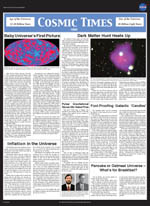1993 Cosmic Times Articles

This poster is the fifth edition of Cosmic Times, with the publication date chosen to coincide with the discovery of anisotropies in the cosmic microwave background (CMB). These "anisotropies" are tiny variations in the remnant radiation from very early in the universe and are seeds of the structure in the universe we see today. This discovery bolstered Big Bang theory by showing that the universe we live in could have formed during the time since the Big Bang.
Jump to:
Content Overview :: Downloads :: Articles :: Lessons :: Style Notes
Content Overview
This fifth issue of Cosmic Times highlights the discovery of tiny variations in the cosmic microwave background. These variations eventually formed the structures that we see around us today. By the early 1990's, astronomers have extended the Big Bang theory to include a period of inflation to make the theory better align with observations. They also refined the distance scale based on a class of supernova, allowing us to determine distances to ever-further galaxies. In addition, the Nobel prize for physics awarded to a pair of scientists who discovered proof of gravitational waves.
Downloads
- 1993 Poster (printable at 8.5" x 11" or at its full size of 24" x 33"): pdf
- 1993 Newsletters:
- 1993 Questions for Understanding: doc, pdf
- 1993 Glossary: doc, pdf
- Full Cosmic Times Glossary: doc, pdf
- Educator's guide for all Cosmic Times editions: doc, pdf
Articles
- Age of Universe: 12-20 Billion Years; Size of Universe: 30 Billion Light Years
Learn more about the age and size → - Baby Universe's 1st Picture
- Summary: Observations by NASA's COBE satellite reveal imperfections (anisotropies) in the remnant radiation from shortly after the Big Bang. These imperfections form the seed of structure that we see in the Universe around us today.
- Thread: Expanding Universe
- Additional background and information →
- Sidebar: Pancake or Oatmeal Universe – What's for Breakfast?
- Summary: The observed imperfections in the cosmic microwave background, while they form the seeds for structures that we see in the Universe today were actually miniscule in size, representing changes from the surroundings of just one part in 100,000.
- Thread: Expanding Universe
- Additional background and information →
- Inflation in the Universe
- Summary: The uniformity of the cosmic microwave background also posed problems for cosmologists because the background was too smooth. Theorists propose inflation as a possible solution to this "smoothness" problem.
- Thread: Expanding Universe
- Additional background and information →
- Fool-Proofing Galactic 'Candles'
- Summary: One class of supernovae appears to be a standard candle that astronomers can use to determine the distances to remote galaxies. This article introduces that concept through a recent revision to the distance scale.
- Thread: Supernova
- Additional background and information →
- Dark Matter Hunt Heats Up
- Summary: X-ray observations of a cluster of galaxies points to the presence of dark matter.
- Additional background and information →
- Pulsar Gravitational Waves Win Nobel Prize
- Summary: A further confirmation of Einstein's General Theory of Relativity is honored with a Nobel prize for a pair of scientists who discover proof of the existence of gravitational waves.
- Additional background and information →
Lesson Plans
Download a .zip file containing all 1993 lessons with their associated handouts: doc, pdf
- Raisin Bread Universe
- What's the Problem with Isotropy
- Gravitational Waves
- Melting Ice
- Dark Matter NASA Conference
Style Notes
The language in the 1993 newspaper mimics the style of writing that would have appeared in a newspaper at that time. The style is similar to modern-day newspapers, and should be easier to read than previous editions. However, the concepts may be harder to grasp, so, as with other editions, we have provided three versions of the text in newletter form: an Early Edition aimed at 7-8 graders, a Home Edition aimed at 9-10 grades (with text from the online edition), and a Late Edition aimed at 11-12 grades (with the text from the poster). These, along with a glossary and questions for understanding are available above.
The poster also shows a layout that mimics the papers of the time (note the introduction of color); however, we have taken some creative license to make it more readable in a classroom setting.



